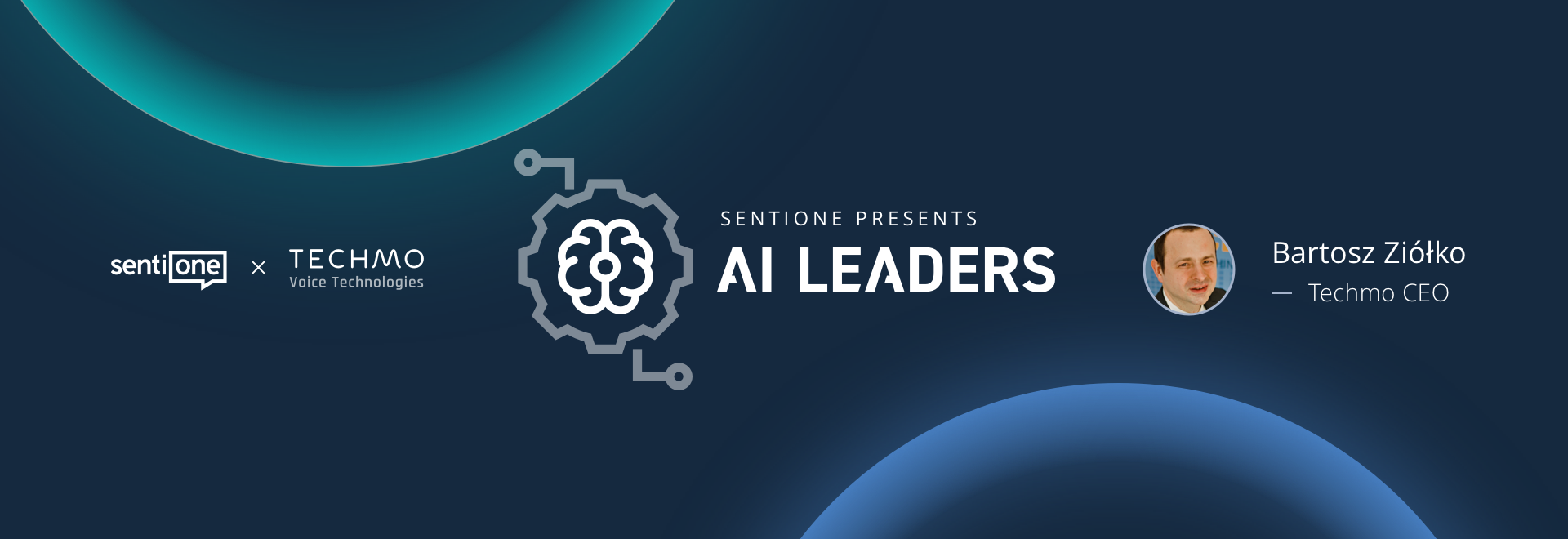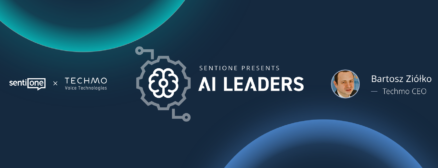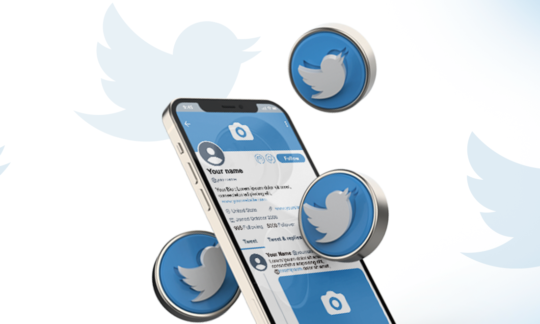SentiOne AI Leaders – interview with Bartosz Ziółko
SentiOne is proud to present a new series of articles – AI Leaders. Over the coming months we’ll take you behind the scenes of the voicebot and chatbot business, talk to industry leaders, experts and solution providers, and take a closer look at the technology behind it all.
To start us off, we invited Bartosz Ziółko, chairman of the board at Techmo. Techmo is an important partner for SentiOne – they provide us with voice recognition and speech synthesis technology, which they have been perfecting for the better part of the last decade. Their solutions cover not only the Polish language, but also English, German and Spanish. Together, we have been working on a voice assistant project for one of the leading Polish banks.
How did you discover the world of voice and speech recognition?
My father was responsible – about twenty years ago, he said that there are two things worth investing in Poland: highways and voice technologies. He put me on the track towards the latter and convinced me to pursue a doctorate in speech recognition. Around the same time, the topic started gaining momentum in Poland. Thus far, I’m not interested in building highways 😉
Can you tell us a little bit about voice solutions from the point of view of an average user? What’s the most common use case for your technology? Where can we see it in our daily lives?
Our technology is designed specifically with large organizations in mind. In practice, this most often means businesses with various restrictions regarding handling personal data. Organisations like that want to optimise their call centres – and this need is what, in my opinion, kickstarted the voice technology boom in Poland.
This technology is now developing in various other directions: applications, user interfaces. Recently, we completed a prototype deployment in a factory – a system for taking quality control notes for products coming off the assembly line. I can also see a secondary trend regarding cloud-based technologies: common applications include voice navigation in cars, as well as simple, everyday tasks, such as text message dictation. This isn’t our niche, however – these solutions are handled by cloud technology providers.
The biggest use of our technology can be observed at a leading telecom, where we handle the entirety of their call centre – this means every single one of several thousand calls each day.
What’s the biggest challenge in voice recognition? What challenges or technological limitations do you most often encounter?
I wouldn’t characterise them as limitations – it’s more like an unending list of exceptions.
For instance, our biggest deployment yet involved around 40 iteration loops – new versions of the product deployed to handle more and more client traffic. Our client would come back to us every once in a while with more feature requests – precisely to handle more and more exceptions.
Telecoms often contend with identity theft – people pretending to be legitimate clients. Sometimes, however, the situation isn’t as clear cut. A “feminine” voice introducing themselves as John Smith doesn’t always mean someone’s pretending to be someone else – after all, what if this particular client happens to be a transgender person?
This, of course, leads to an exception that needs to be considered – does a stereotypically “feminine” voice automatically imply we’re talking to a woman? A similar case needs to be considered with regards to age: you might have a number registered to a 50-year-old man, who just happens to have an unusually youthful voice. These kinds of cases are the most difficult, because system designers don’t take them into account until they appear. It’s practically impossible to anticipate situations like that until the system is deployed and faces a “reality check”.
In your opinion, where is the voice technology business heading?
This depends whether we’re talking about voicebots or voice technology as a whole. Voice assistants haven’t yet been adopted en masse in Poland; to us, however, it’s considered the proverbial “red ocean”. This particular sector is highly competitive – a lot of providers are trying to compete on price alone. Because of this, we’re focused on finding new, niche applications for voice technology.
So far, we’ve keyed in on two applications in particular. The first is real-time speech analytics and voice channel monitoring. We call it “the Boss’ ear”. The second application is controlling all sorts of devices: we’re not only talking about the ever-growing Internet-of-Things market, but also industrial robotics, for instance.
Devices designed for employees have a crucial business advantage – the systems behind those devices are used by a consistent group of people that can be trained. We can assume, then, that their interactions with the system can be repeatable, easier to predict. If we’re talking about a smart washing machine, though, the opposite is true – there’s a much greater probability of unpredictable behaviour.
Now, with COVID-19 dominating our daily lives, non-touch interfaces are on the rise. As such, voice controls are a great answer to this. Factory workers often have their hands full or wear heavy protective gloves – voice interfaces are a natural fit. Industrial solutions are the future of the business.
There’s no denying that 2020 was a difficult year – in your opinion, how did it impact the world of voice technology? Did you have to change or adapt?
One of the biggest negative changes that 2020 brought down on us is definitely the lack of face-to-face meetings. Our business model is based on partnerships – as such, meetings are crucial. We purchased a company car at the start of the year, but we barely use it. This presents a serious challenge – voice technologies are still considered a “new thing”, which understandably makes clients anxious. There’s no better way to address concerns and help clients understand the technology than in person – after all, talking is all well and good, but body language also plays a major role.
We’re currently working on large projects, which can be a little bit unwieldy in remote conditions. Voice technologies are sure to become more and more popular, but we haven’t yet observed any explosive growth in Poland – it’s too early for that. Thus far, we saw a large boom in sales and development among companies that experienced growth during the pandemic – they are investing heavily in automation. A deeper revolution will come in the future, likely in response to the pandemic. Even if it ends soon, concerns and fears will remain – new sales channels and products will be evaluated primarily through that lens.
Do you agree with the sentiment that the pandemic accelerated the digital revolution in Poland?
We have a client that was going to implement voice solutions before the pandemic, but they stopped all of their projects in March. The business that company was particularly impacted by social distancing measures – it could have gained a lot by implementing touch-free solutions. Larger companies were better prepared to remain viable for longer; in my opinion, these problems are a less significant factor than the need for remote operations.
I think Poland had a lot of luck – a lot of digital solutions, such as online prescriptions and ePUAP were ready for prime-time even before the pandemic.
How are you handling remote working? Do you have any tips on how to maintain a good team atmosphere despite the lack of coffee machine chats?
We couldn’t maintain a good company atmosphere, but that’s because a lot of people were more concerned with their health rather than workplace relationships. Organising remote work was a definite challenge. A couple of employees left us shortly before the pandemic, so we entered the crisis with a lean dream team – that proved to be a blessing in disguise. I don’t think we lost momentum. We even recruited new talent during the peak of the pandemic; we’re very satisfied with the fresh blood in the company.
Where do you see yourself in a year? What are Techmo’s goals for the next twelve months?
The two main directions we’re pursuing are speech analytics and foreign languages. Personally, I’m focused on developing our presence on foreign markets. We’re preparing a pilot deployment for the English market with one of our partners; with another, we’re working on a Spanish project. We also want to enter the stock market.



